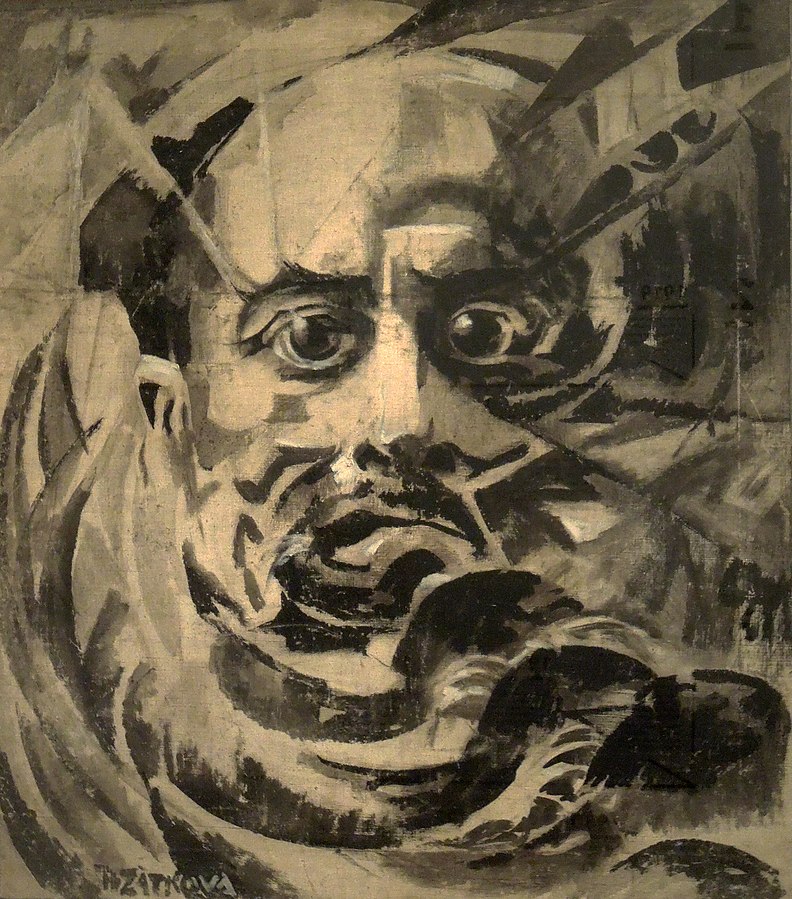Centered in Italy and led by Filippo Tomasso Marinetti, Futurism was a movement in twentieth-century aesthetics that emphasized a rejection of the past and glorification of speed, power and violence. Focused especially on technological innovation and mechanical power, the Futurists wanted to convey the sensations of speed and movement in their writing. Like Cubist writers, they blurred poetry and art and called for a ‘typographical revolution’ that would free words from the strict visual forms they traditionally took on the page. However, Futurists uniquely emphasized speed, and part of their use of different font sizes and unusual lineation was to immediately convey a strong emotion or sense of movement to the reader. They wrote in pictograms, collage, and “sintesi” (minimalist plays).
 "Portrait of Filippo Tommaso Marinetti" by Růžena Zátková, painting, 1915-1921 | Public Domain.
"Portrait of Filippo Tommaso Marinetti" by Růžena Zátková, painting, 1915-1921 | Public Domain.
Marinetti wrote the Futurist Manifesto in 1913, which articulated the group’s desire to emulate modern technologies’ powerful forms in self-consciously provocative ways. Other famous Italian Futurists were Carla Carra, Umberto Boccioni, Luigi Russolo, and others. As a group, they advocated for the destruction of tradition to an extreme degree that often approached a flirtation with violence. In the 1920s, they supported fascism and Mussolini, and their distinctive literary collage style influenced twentieth-century war propaganda.
Map of Futurist Manifestos
Russian Futurism began with Viktor Khlebnikov, and divided into two schools: cubo-futurism and ego-futurism. Cubo-futurism was characterized by a desire for universal communication and pure language. This branch of futurism experimented with sound poetry, and invented Zaum, a “transrational” language which was supposed to transcend logic to communicate directly. A Zaum-poem is included in this database. Ego-futurism focused on urbanization, coining new words, and egocentrism.
Futurism influenced German Expressionism, English Vorticism, and International Dada.
References
Alomar, Gabriel, and Merjian, Ara H., tr. “Futurism.” Modernism/modernity (Baltimore, Md.) 17.2 (2010): 409–420.
“Futurism.” "Encyclopædia Britannica Online". Encyclopædia Britannica Inc, 2020.
Humphreys, Richard. Futurism. Cambridge ; New York: Cambridge University Press, 1999.
Janecek, G. J. “Futurism.” The Princeton Encyclopedia of Poetry and Poetics, Princeton University Press, 2012.
Martin, Sylvia, and Grosenick, Uta. Futurism. Köln ; London ; Los Angeles: Taschen, 2005.
Ottinger, Didier., Centre Georges Pompidou, Scuderie Papali al Quirinale, and Tate Modern. Futurism. Rev. and enlarged English ed.. Paris : Milan: Éditions du Centre Pompidou ; 5 Continents, 2009.
Tisdall, Caroline., and Bozzolla, Angelo. Futurism. New York ; Toronto: Oxford University Press, 1978.